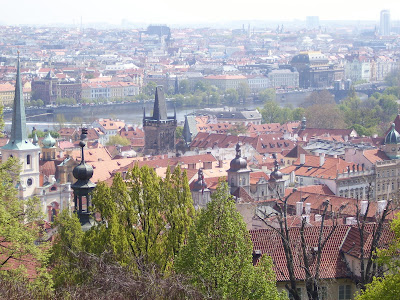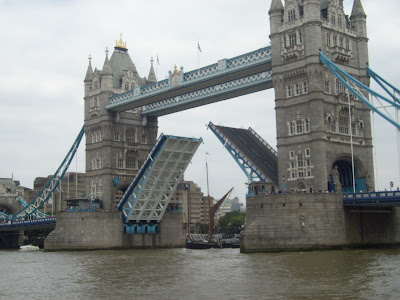I just found out that children are not routinely vaccinated against chickenpox in England. It is believed that giving children the vaccine could increase the risk of shingles in older people. Most people who grow up in England get the disease as kids so they are immune as adults. Naturally, some kids at the American school that Lexi goes to are now getting chickenpox.
Some American friends here that are moving back to the States were at their GP's surgery (translation: General Practitioner's office) recently. They were trying to explain why the school they are transferring to only requires the younger kids to get the chickenpox shot (or "jab" as they say here) and not the oldest kid. The school has a "grandfather clause" which exempts the older kids from the vaccine. The doctor had never heard the term "grandfathered".
Even after living here almost two years, I still discover subtle differences that remind me I'm not in my home country.
Friday, June 17, 2011
Tuesday, June 7, 2011
Two Trips to Prague
Chris and I recently spent 3 days in Prague over the Easter break. It was a meaningful trip because we had also visited Prague 21 years ago in 1990 just as the walls of communism were falling.
My great-grandparents on both my mother's and father's side emigrated from what was then Moravia. My grandmother kept in touch with the relatives who stayed behind in Czechoslovakia by writing letters. After the fall of communism in 1989 the borders were opened making it easier to return to the country of my family's origin. How wonderful that we still had contact information for the relatives living there.
In May 1990, my relatives gave us a wonderful whirlwind tour of Prague in one day. It was so exciting being there at that time when free enterprise was just being discovered and hatred of the past government was evident. We saw lots of graffiti like on the plaque below. It was on a bridge saying it was dedicated to Gottwald, Communist president, in 1973. The word "killer" was painted over it.
This time in Prague we visited the Museum of Communism. It was fascinating to see the events that were so fresh during our last trip now documented as history. The fall of communism in Czechoslovakia is called the "Velvet Revolution" because it went so smoothly. The photo below shows a makeshift monument in 1990 to the Czech heroes at Wenceslas Square where demonstrations were held. There was melted wax all around the edges from candles. Today this is just a flower bed.
Prague is now a very touristy place, so different from 21 years ago, and yet the beautiful churches, the history, and the famous Charles Bridge remain the same. The pivo is still very good and inexpensive too!
We saw tourists lined up at a spot between two buildings. Naturally, we had to check it out. It was a narrow passageway with a traffic signal so pedestrians can flow single-file in one direction at a time to get to a neat restaurant on the river. Clever marketing.
I was excited to see that Kiefer Sutherland, aka Jack Bauer from 24, had stayed at our hotel, the Alchymist Residence Nosticova. Jack would be proud to see the injustices of communism gone from Prague!
 |
| On Charles Bridge 2011 |
 |
| On Charles Bridge 1990 with Jan and Juroslav, Czech relatives |
My great-grandparents on both my mother's and father's side emigrated from what was then Moravia. My grandmother kept in touch with the relatives who stayed behind in Czechoslovakia by writing letters. After the fall of communism in 1989 the borders were opened making it easier to return to the country of my family's origin. How wonderful that we still had contact information for the relatives living there.
In May 1990, my relatives gave us a wonderful whirlwind tour of Prague in one day. It was so exciting being there at that time when free enterprise was just being discovered and hatred of the past government was evident. We saw lots of graffiti like on the plaque below. It was on a bridge saying it was dedicated to Gottwald, Communist president, in 1973. The word "killer" was painted over it.
 |
| May 1990 |
 |
| May 1990, Wenceslas Square The square is named after Saint Wenceslas, the patron saint of Bohemia, and yes, the same guy in the Christmas carol, "Good King Wenceslas". |
Prague is now a very touristy place, so different from 21 years ago, and yet the beautiful churches, the history, and the famous Charles Bridge remain the same. The pivo is still very good and inexpensive too!
 |
| Prague, April 2011 |
This memorial book is in the St. Vitus Cathedral.
 |
| Memorial Book of Czechoslovak Airmen 1939 - 1945 |
We saw tourists lined up at a spot between two buildings. Naturally, we had to check it out. It was a narrow passageway with a traffic signal so pedestrians can flow single-file in one direction at a time to get to a neat restaurant on the river. Clever marketing.
I was excited to see that Kiefer Sutherland, aka Jack Bauer from 24, had stayed at our hotel, the Alchymist Residence Nosticova. Jack would be proud to see the injustices of communism gone from Prague!
Saturday, June 4, 2011
Tower Bridge
While Ryan is home from university and before he starts his summer internship in London, we've been trying to get out and about and do the sightseeing stuff. We took a tour of the famous Tower Bridge in London.
The iconic Tower Bridge that is seen in so many photos of London is often mistakenly called the London Bridge. It is located near the Tower of London so I suppose that's where it gets its name. The London Bridge was getting so crowded that a new bridge was built in 1894 to offload some of the traffic.
The new bridge was considered a triumph of engineering at the time, using hydraulic power on a scale never attempted before. A steam engine powered a see-saw type mechanism for raising and lowering the drawbridge. The hydraulic power was also used to operate elevators in the towers to take pedestrians up to the walkways. The idea was that pedestrians wouldn't have to wait to cross while the drawbridge was lifted for a ship to pass through. They could go up to the walkways and walk across well above the drawbridge activity below.
Sometimes the best plans are for naught, however. The drawbridge was able to be raised and lowered so quickly that the pedestrians preferred to just wait. The walkways were closed by Parliament in 1910 due to a lack of use.
Today, the walkways are used for an exhibition showing the history of the bridge. They still provide stunning views over the river.
I found it interesting that the bridge was only minimally damaged during World War II. The Germans found it a useful navigational landmark to guide them to the rest of the city so they avoided bombing it.
 |
| Tower Bridge in background |
The new bridge was considered a triumph of engineering at the time, using hydraulic power on a scale never attempted before. A steam engine powered a see-saw type mechanism for raising and lowering the drawbridge. The hydraulic power was also used to operate elevators in the towers to take pedestrians up to the walkways. The idea was that pedestrians wouldn't have to wait to cross while the drawbridge was lifted for a ship to pass through. They could go up to the walkways and walk across well above the drawbridge activity below.
 |
| Letting a sailboat pass |
Sometimes the best plans are for naught, however. The drawbridge was able to be raised and lowered so quickly that the pedestrians preferred to just wait. The walkways were closed by Parliament in 1910 due to a lack of use.
Today, the walkways are used for an exhibition showing the history of the bridge. They still provide stunning views over the river.
I found it interesting that the bridge was only minimally damaged during World War II. The Germans found it a useful navigational landmark to guide them to the rest of the city so they avoided bombing it.
Subscribe to:
Comments (Atom)


